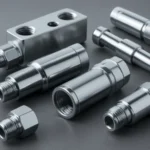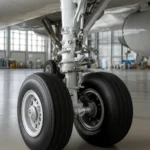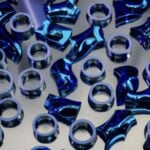When you think about what makes airplanes, spacecraft, and all things aerospace tick, you might picture engines, wings, and cutting-edge technology. But there’s something less glamorous, though equally important, that keeps these systems running smoothly: the surface treatments that protect parts from wear and tear.
One of the unsung heroes in this world is chromic acid anodizing, also known as Type 1 anodizing. It’s a process that does wonders for aluminum parts, which, let’s face it, are everywhere in aerospace. Whether it’s the body of an aircraft or the delicate components inside a spacecraft, anodizing helps them survive the harshest conditions—without adding unnecessary weight.
But what exactly is chromic acid anodizing, and why is it such a big deal in aerospace? Let’s dive into it.
What Is Chromic Acid Anodizing?
At its core, chromic acid anodizing is a process that transforms the surface of aluminum to make it tougher, more durable, and corrosion-resistant. By immersing aluminum in a special chromic acid bath and running an electric current through it, a protective layer of aluminum oxide forms on the surface. This oxide layer is incredibly hard, resistant to corrosion, and most importantly—thin enough not to mess with the lightweight properties of aluminum.
So, why “chromic acid”? Well, it’s a specific type of acid that makes the anodized layer a bit different from other anodizing methods, like sulfuric acid anodizing. This thin yet tough layer helps to protect aluminum parts from everything from the salty air at sea level to the extreme conditions at 30,000 feet or beyond.
How It Works (In Simple Terms)
Here’s how it all comes together:
- Cleaning – The aluminum part is thoroughly cleaned to remove any oils, dirt, or residue.
- Anodizing – The part gets dipped into a bath of chromic acid, and an electric current is applied. This causes the aluminum to react with oxygen ions from the acid, forming a durable aluminum oxide layer.
- Finishing – After the anodizing, the part may be sealed to ensure extra protection and prevent the oxide layer from becoming too porous.
The result? A tough, lightweight surface that’s perfect for aerospace applications where performance, safety, and reliability are non-negotiable.
Why Is It So Important for Aerospace?
In aerospace, every ounce matters, and every part needs to stand up to extreme conditions. Here’s where chromic acid anodizing really shines.
1. Light and Tough
We know aluminum is lightweight, which is a huge bonus in the aerospace world. But to get the most out of it, you also need it to be strong and resistant to wear. The anodizing process creates a hard, tough surface that resists scratches, abrasions, and even corrosion—without weighing anything down. That means your aircraft can endure all kinds of stresses while keeping that crucial weight down.
2. Corrosion Resistance
Imagine flying at 30,000 feet or higher. The air is thin, the temperatures are freezing, and there’s a ton of moisture in the air. Without protection, aluminum would corrode quickly. This is where chromic acid anodizing steps in. It forms a protective layer that keeps moisture, salt, and other elements from attacking the aluminum, ensuring that parts last longer and stay in top shape.
3. Fatigue Resistance
Parts of an aircraft or spacecraft experience stress, and sometimes a lot of it. Whether it’s from vibrations or repeated movement, you need materials that won’t crack or fail over time. The anodized aluminum, thanks to that tough oxide layer, can better withstand the repetitive forces that come with regular use, making it less likely to fail under pressure.
4. Bonding Made Easy
In aerospace, parts don’t always just “screw” together. Many times, adhesives and bonding agents are used to hold components together. The beauty of chromic acid anodizing is that it helps create a surface that bonding agents can easily stick to. This means a stronger bond and fewer chances of parts coming loose during operation.
5. Aesthetic & Functional Finishes
It’s not all about performance. Sometimes, aerospace parts need to blend into a larger system (think stealth aircraft, for example) or simply need to maintain a sleek look. The anodizing process creates a matte finish, so there’s no reflection, which is important in reducing visibility for military or security purposes. It also looks great, making sure the technical parts are as polished as they are functional.
Where Do We See This in Action?
So, where exactly does chromic acid anodizing come into play in the aerospace world? You’d be surprised how often it’s used. Here are just a few areas:
- Aircraft Bodies and Frames: From wings to fuselages, chromic acid anodizing protects these large, crucial parts from the elements, ensuring they don’t degrade over time.
- Landing Gear & Brakes: Landing gear parts and brake systems take a serious beating. They need to be able to handle tons of pressure, weight, and environmental stress. Anodizing improves both their strength and lifespan, making sure they perform when they’re needed most.
- Engines & Turbines: Turbine blades, engine mounts, and other critical components benefit from the corrosion and fatigue resistance provided by chromic acid anodizing. In a high-stakes environment like an engine, every little bit helps!
- Spacecraft & Satellites: The conditions in space are brutal—extreme temperatures, radiation, and vacuum. Chromic acid anodizing helps aluminum components survive these conditions, ensuring spacecraft and satellites can function properly.
The Bottom Line: Why It Matters
When it comes to aerospace, there’s no room for error. Parts must be tough, reliable, and able to perform in the harshest conditions possible. Chromic acid anodizing, or Type 1 anodizing, is one of the best ways to ensure aluminum parts meet these high standards. It’s light, durable, corrosion-resistant, and it helps parts withstand mechanical stress and extreme environments.
In short, this surface treatment process makes aerospace technology not only safer and longer-lasting but also lighter and more efficient. And that’s something everyone in aviation—from manufacturers to passengers—can appreciate. Contact us today for a quote or visit our website at www.aerospacemetalsllc.com and we would be happy to discuss your metal finishing needs with you.






